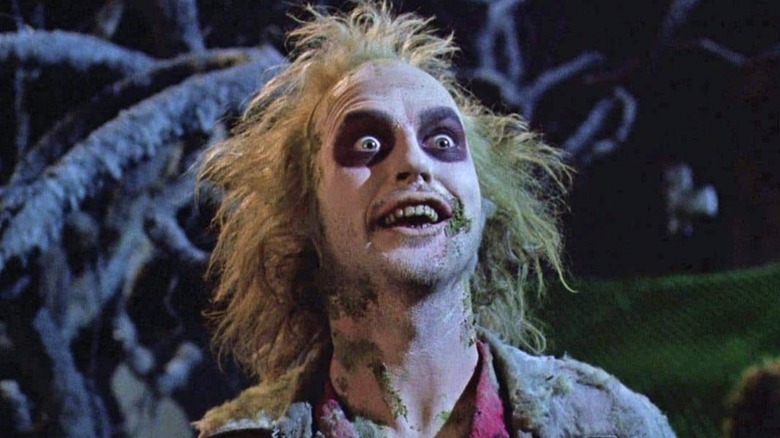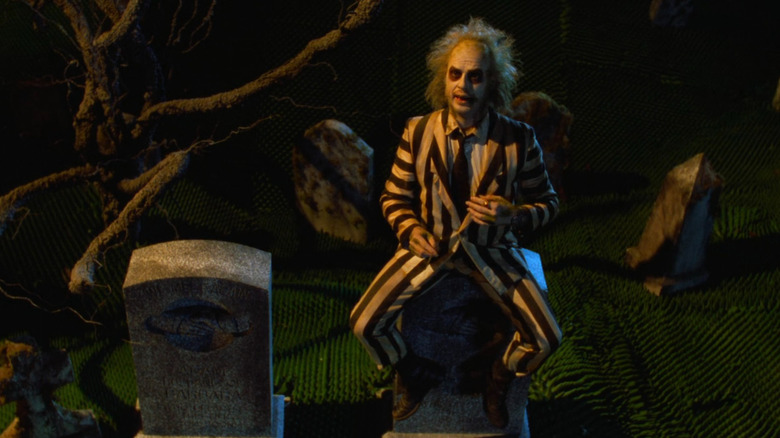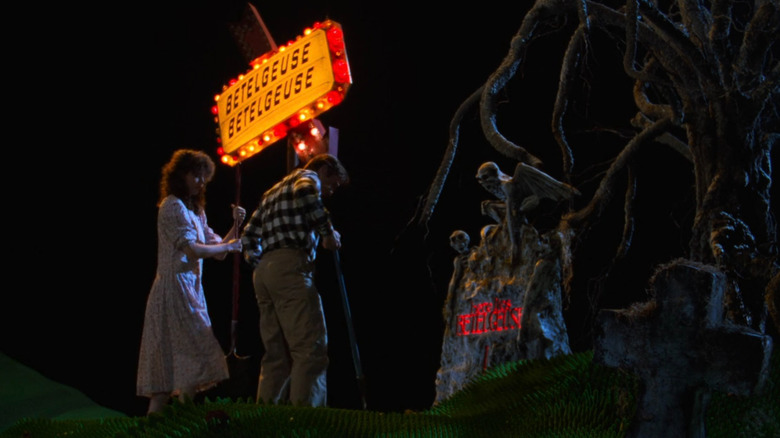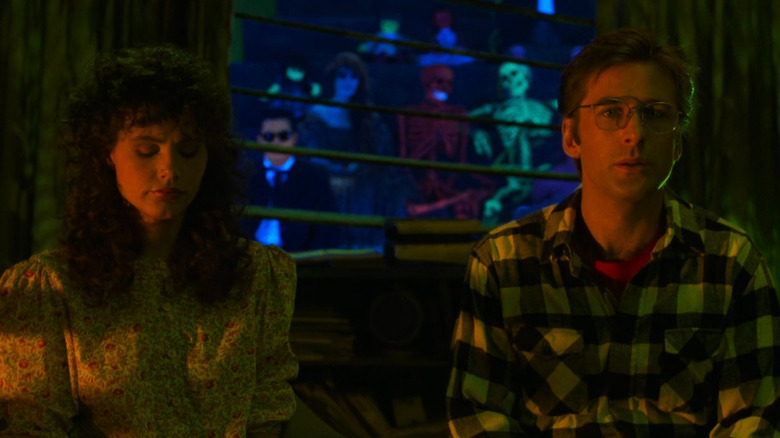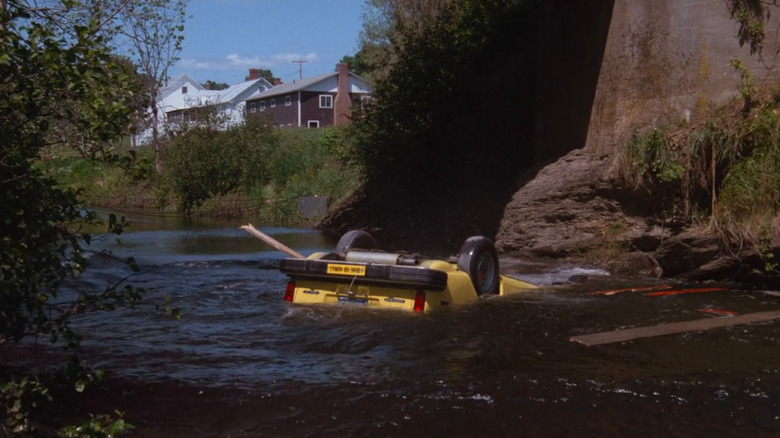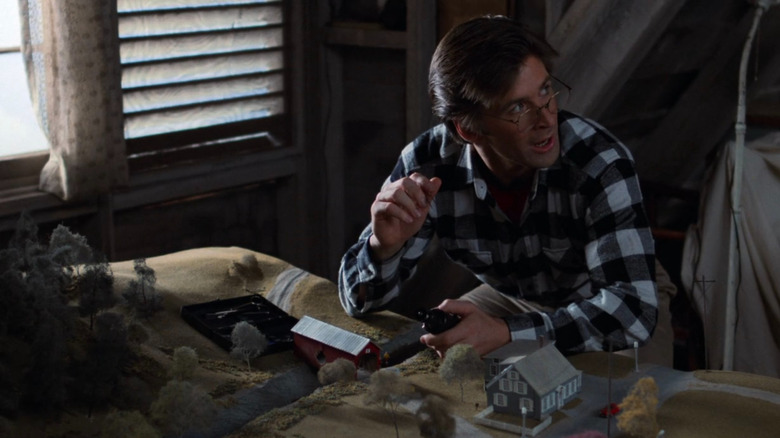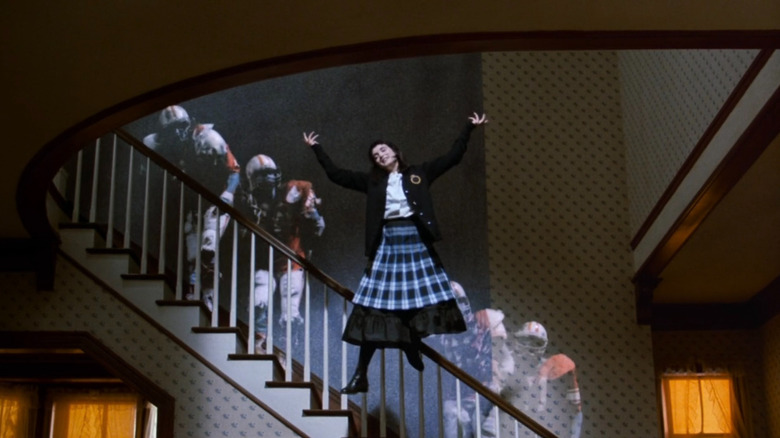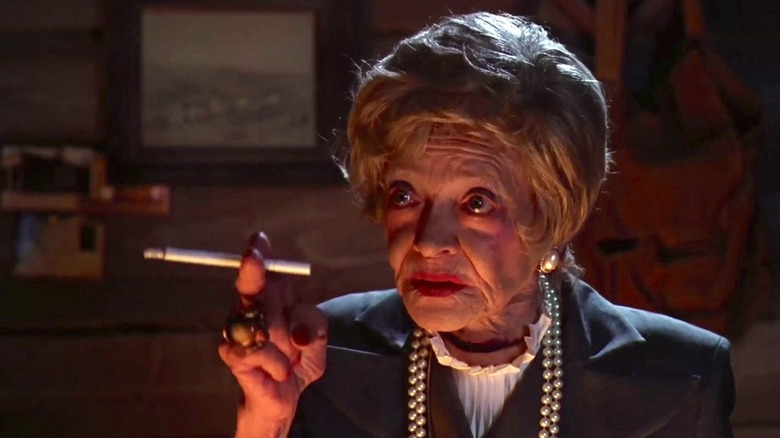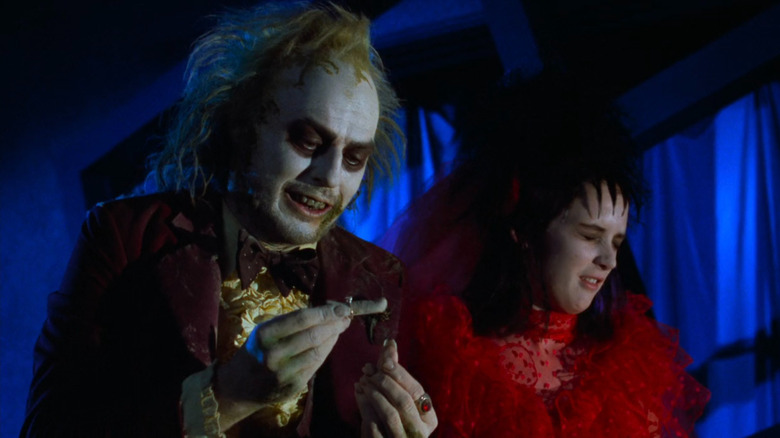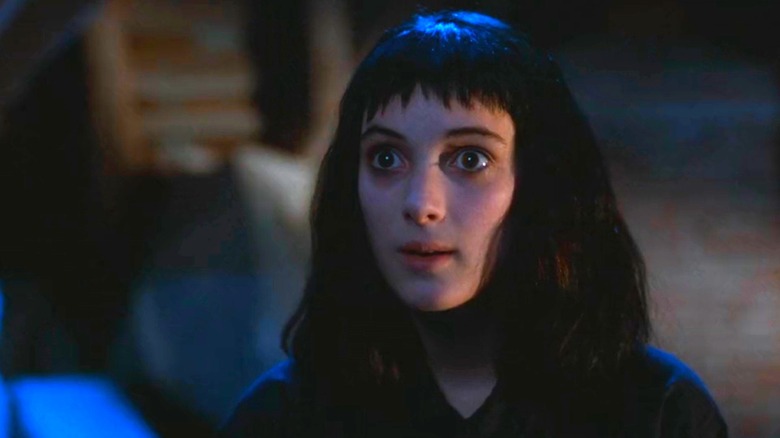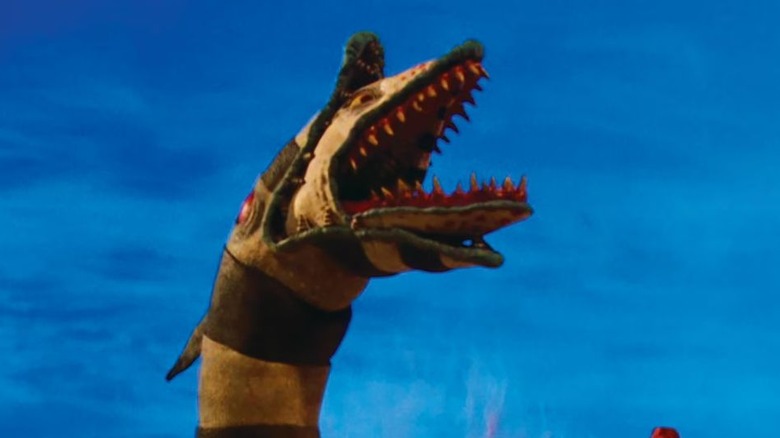We Rewatched Beetlejuice And Here's What We Noticed
"Beetlejuice" is a beloved classic now, but it's easy to forget how off-the-wall it must've seemed when it debuted in 1988. Anyone who went to see Alec Baldwin and Geena Davis as the doting couple Adam and Barbara Maitland may have been put off by seeing them meet tragic demises so early in the film. From there, they haunt the house that's now inhabited by the Deetzes, including their goth daughter Lydia (Winona Ryder). There are moments that may freak out any kids, but death and the afterlife are ultimately played for laughs.
Some were turned off by the story, including Roger Ebert, who wrote, "The movie is all anticlimax once we realize it's going to be about gimmicks, not characters." Of course, time and the general public have proved him wrong. Audiences fell in love with "Beetlejuice" and its eclectic assortment of characters, chiefly among them the titular Beetlejuice (Michael Keaton), who ranks first as the most iconic Tim Burton character ever. The movie did well at the box office and spawned a cartoon, several video games, and a Broadway musical. It all culminated in 2024 with the release of a live-action sequel, "Beetlejuice Beetlejuice," which blew everyone away at the box office, proving the Ghost with the Most still has it.
With the original "Beetlejuice" readily available to stream on Max and frequent playings on cable during the Halloween season, there are plenty of opportunities to rewatch it. And when you do, there may be Easter eggs and pieces of foreshadowing you pick up on with fresh eyes.
Beetlejuice only has his iconic suit for a few minutes
There's a surprising Michael Keaton detail in "Beetlejuice" you likely never realized before. Beetlejuice himself only shows up for 17 of the movie's 92 minutes, despite being the title character. But you know what they say: There are no small parts; only small actors. Michael Keaton made the most of his limited screen time, and what's even more shocking rewatching "Beetlejuice" is that the silly demon only wears his iconic black-and-white striped suit for just two of those minutes.
It's a slick outfit, and it's incredible to think how the character has become synonymous with it despite him only wearing it for a short while. The "Beetlejuice" cartoon sees him wearing it all the time, albeit with a purple shirt under the jacket as opposed to the white one in the film. And it should come as no surprise the iconic suit returns once more in the sequel.
Despite appearing so briefly, Beetlejuice has quite the extensive wardrobe in the movie. At various points, he sports a demented tour guide outfit, Adam Maitland's clothes, and his maroon wedding suit. It turns out Beetlejuice isn't just a trickster demon. He's also an undead fashionista.
The number three comes up a lot
Some cultures believe three is an unlucky number, and that may be why it comes up so frequently when Beetlejuice is around. Naturally, one has to say Beetlejuice's name three times to summon him, and Barbara says, "Home," three times to get away from him. But the motif comes up frequently throughout the first movie.
When one creates a door to the afterlife, they then have to knock three times. When Adam and Barbara are in Juno's (Sylvia Sidney) office, someone over the intercom states how Flight 409 has arrived at Gate 3, and the couple learns they only have three intercessions with Juno to help them. In one scene, Beetlejuice wears three watches on his wrist. Delia Deetz (Catherine O'Hara) complains after they move into the new house that there are only three of her sculptures around when there should be four. That's nothing to say of the house itself, which has three stories.
Finally, the end of the film sees Beetlejuice in the afterlife waiting room, where his number to be helped is 9,998,383,750,000. The next number up is — you guessed it — three. It may not mean anything too deep, or it could hint at the ultimate endgame for the series. The ending of "Beetlejuice Beetlejuice" leaves the door open for more misadventures in the afterlife, so perhaps the franchise will finally become a trilogy. If it does, the title should absolutely be "Beetlejuice Beetlejuice Beetlejuice."
Jake Blues from The Blues Brothers maybe has a cameo
When Adam and Barbara are in Juno's office, the window behind them reveals a collection of characters seemingly watching the same thing we are. Or perhaps they're waiting for their turns to speak with Juno about all of their grievances. However, viewers should look closely at these characters, as there are some intriguing individuals to note. There's a green and red skeleton, which look an awful lot like the green and red skeletons aliens turn people into in the 1996 Tim Burton movie, "Mars Attacks!" There's also a woman with long hair and blue skin who almost looks like Delores (Monica Bellucci) from "Beetlejuice Beetlejuice," although we know that she was locked up in various boxes from that movie, so it couldn't be her.
Lastly, there's a man wearing sunglasses who bears a physical similarity to Jake Blues (John Belushi) from 1980's "The Blues Brothers." There's no confirmation that's who it's supposed to be, but it could be seen as a nod to the late Belushi, who died in 1982.
Some online aren't convinced it's meant to be Jake Blues, as one Redditor posted on a thread concerning the detail: "I always thought it was Roy Orbison." The sunglasses are somewhat Orbison-esque, but it would be a little freaky if that's who it's meant to be, considering that "Beetlejuice" came out on March 30, 1988, with Orbison dying later that year on December 6. Perhaps it's not supposed to be anyone in particular, but the resemblance to another beloved '80s movie character makes for a good story.
The bumper sticker points to irony
One reason why "Beetlejuice" has persevered as a classic for all these years is its twisted sense of humor. Beetlejuice himself has plenty of hilarious moments, and many macabre moments are played for laughs, such as Barbara ripping her face off to scare Delia and Otho (Glenn Shadix), only for them to act nonplussed since they can't see her. However, there's one subtle foreshadowing moment that may fly over most people's heads the first time they watch the movie.
Adam and Barbara drive through town in a yellow Volvo, and while it never gets a close-up, you can zoom in to see there's a bumper sticker that reads "I Brake For Animals." In an ironic twist, Barbara doesn't brake at all when they come upon a dog at the covered bridge. Adam grabs ahold of the wheel to swerve them out of the way, causing them to crash into the side. The dog repays the Maitlands by hopping off the one board that kept them in place, and when it's gone, they plunge to their watery deaths.
Perhaps the dog was merely getting revenge for another pup in Tim Burton's filmography. In 1984, Burton released the 29-minute film, "Frankenweenie," about a boy who brings his dog back to life after it was hit by a car. This would later be adapted into a full-length stop-motion animated film of the same name, but luckily for all the dog lovers out there, the canine survives in "Beetlejuice" at the expense of our protagonists.
The town model changes after the Maitlands' crash
Speaking of the Maitlands' crash, its ramifications go even beyond Adam and Barbara's deaths. They return to the house as ghosts, which they only really become aware of after realizing they no longer have reflections in the mirror. Afterward, they wind up in the attic containing the model of Winter River, Connecticut. It's a safe space for them, and, similar to the bumper sticker, eagle-eyed viewers may have realized there's now a change to the covered bridge.
As Adam is hunched over the model, one can see that the model's bridge now has a hole in it where their car would've crashed through. It could just be a fun detail; however, Adam does seem to be working on the model, so perhaps he added it there. It's a little morbid, but maybe it functions as exposure therapy for him to reflect on the event that ended his and Barbara's lives.
It's the kind of detail that doesn't impact the plot or character development in any way. It's just a fun thing to point out to friends when you all rewatch "Beetlejuice" together.
Beetlejuice originally had a much darker ending
The ending of "Beetlejuice" is perfectly in line with the morbid humor throughout the rest of the film, as Lydia finally feels like she belongs. She commiserates how the Maitlands and Deetzes will exist in the house together, which she celebrates by dancing and singing "Jump in the Line" by Harry Belafonte. It's a quirky way to end a future classic, but the original "Beetlejuice" ending was supposed to be much darker and could've left a bad taste in audience's mouths.
The original script from Michael McDowell was far darker overall. For example, when the Maitlands crash into the covered bridge, a piece of piling was supposed to smash into Barbara's arm, causing her to wail out in pain. Killing characters is always dark, but making it quick and to the point by suggesting they drown makes it easier to go down. Additionally, Lydia wasn't supposed to survive at the end. An earlier version has her die in a house fire so that she joins the Maitlands as a ghost in the afterlife.
It would've been a far more downbeat ending, and it's possible it would've made people more hesitant to revisit the film over the years. Additionally, it would've taken the impact out of Lydia talking about how she wants to be dead in "Beetlejuice" only for Barbara to tell her, "Being dead really doesn't make things any easier." "Beetlejuice" shows how wonderful life can be, and we get the chance to see Lydia become a mother of her own in "Beetlejuice Beetlejuice."
How the heck is Beetlejuice rated PG?
The real story behind the creation of the PG-13 rating is that it was made in response that films that weren't entirely kid-friendly but didn't warrant something as extreme as R. As such, PG-13 was used for the first time in 1984 with "Red Dawn," so seeing as "Beetlejuice" came out four years later, one might reasonably surmise it also got a PG-13 rating due to its frightening imagery, crass humor, and occasional profanity. However, "Beetlejuice" somehow wound up with a PG rating.
If nothing else, Beetlejuice himself yells "Nice [expletive] model!" which would automatically seem to put it in PG-13 territory. It's far from the only obscenity. That's nothing to be said of the myriad of freaky ghouls and ghosts, including a man flattened with tire marks and a woman sawed in half. While there's no nudity or overt sexual situations, there's a lot of innuendo, with Beetlejuice even heading into a brothel called Dante's Inferno Room.
It seems to come down to the Motion Picture Association of America being far more lax with what PG movies could get away with. Look at "Big" starring Tom Hanks, which also came out in 1988. That movie has sexual situations and use of bad language, but it's rated PG for all the kids to see (with parental guidance, of course). Now, there are far stricter rules, and it explains why "Beetlejuice Beetlejuice" is PG-13, even though it's no more profane than the first film.
Beetlejuice foreshadows with a finger
The idea of a "Beetlejuice" sequel was being bandied about pretty much immediately after the first film did well at the box office. "Beetlejuice Goes Hawaiian," a canceled comedy sequel we wish we could see, seemed like a fun Beetlejuice story to pursue. Instead, "Beetlejuice Beetlejuice" came out 36 years after the original, and a major component of the follow-up is built off a throwaway joke from the original.
When Beetlejuice is about to marry Lydia, he pulls out a severed finger with a wedding ring on it while telling his bride-to-be, "She meant nothing to me. Nothing!" This line implies Beetlejuice was married once before, and it's hilarious to think about someone actually wanting to marry this guy. The sequel introduces his former lover, Delores. It turns out she poisoned Beetlejuice, and before he passed away, Beetlejuice chopped her into little bits, which explains why he has her finger readily available.
Whether the plan was always to introduce Beetlejuice's ex-wife at some point is debatable (and highly unlikely). But it's a neat thing to pick up on with "Beetlejuice" rewatches, as such a tiny detail ended up expanding his lore in a really interesting way.
I myself am strange and unusual ... and a chosen one
1988's "Beetlejuice" introduced the world to Lydia Deetz, who became an instant icon due to her non-conformist attitude. A generation of teenagers who didn't relate to adults could see parts of themselves in her, and this is exemplified in her conversation with Adam and Barbara when she explains why she can see them whereas others can't: "I myself am strange and unusual." This line not only summarizes Lydia as a character but also implies that anyone can see and speak with the dead if they embrace their own inherent weirdness. That's all fine and well, but it would appear "Beetlejuice Beetlejuice" may have retconned the rationale for Lydia's supernatural powers.
In "Beetlejuice Beetlejuice," a now-adult Lydia provides to her daughter, Astrid (Jenna Ortega), a different explanation for her powers: "This ability didn't exactly come with instructions; it happened when I was about your age." That line makes it sound as though it's a paranormal gift that's seemingly passed down via genetics since we discover Astrid can do the same thing when she hangs out with Jeremy (Arthur Conti), who she discovers after the fact is already dead.
It's possible this isn't so much a retcon as a misunderstanding. Perhaps Lydia didn't realize she had a special gift unique to her when she was a teenager. Her saying that she's strange and unusual may have been her attempt to explain what's going on, and she learned later that not just any goth can talk with ghosts. It may not necessarily matter, but Lydia having a special power makes her more of a "chosen one" archetype rather than existing in a more whimsical world where a lot of people could talk with ghosts if they embrace their inner oddities.
One appreciates the practical effect upon rewatching Beetlejuice
One reason why "Beetlejuice" has persisted all these years could be attributed to how it utilizes practical effects, like makeup and stop-motion animation. Even if things don't look intrinsically "real," it adds to the film's overall charm, and going back to watch "Beetlejuice" can make one appreciate just how much care was put into the film.
The behind-the-scenes footage fom the film shows the team crafting the Beetlejuice snake. It's remarkably impressive, as it has numerous points of movement to make its upper eyes and lips more expressive. A similar puppet was created for the sandworm, which was brought to life using stop-motion. That's nothing to see of the extensive makeup on display, where all of the deceased characters truly tell a story with their various fatal injuries being exaggerated. It's no wonder "Beetlejuice" won an Academy Award for best makeup at that year's ceremony.
Numerous artisans came together to create something really special with "Beetlejuice," and its sequel leaned heavily on a similar aesthetic despite technology coming a long way over the past 36 years. It gives the movies a more timeless quality, and people will undoubtedly keep rewatching Beetlejuice's antics for many more years to come.
